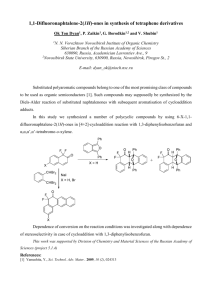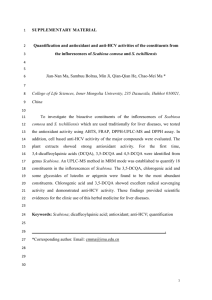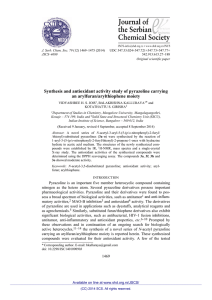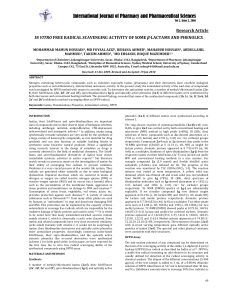N-Phosphorylated Derivatives of 5-Nitroindazole as
advertisement
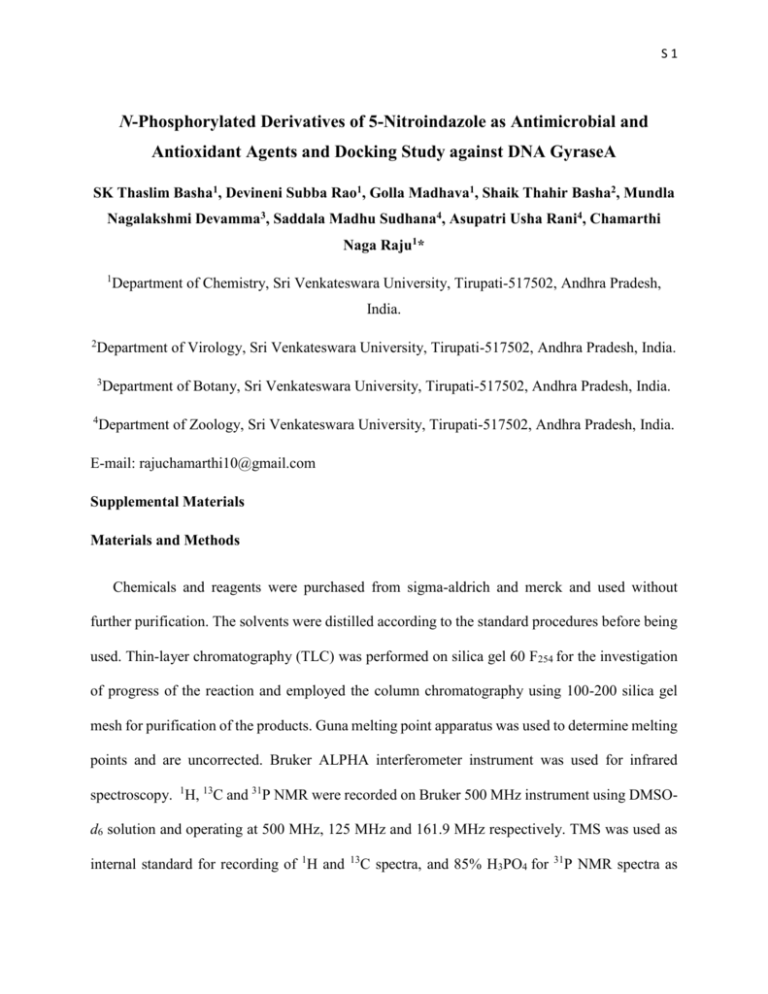
S1 N-Phosphorylated Derivatives of 5-Nitroindazole as Antimicrobial and Antioxidant Agents and Docking Study against DNA GyraseA SK Thaslim Basha1, Devineni Subba Rao1, Golla Madhava1, Shaik Thahir Basha2, Mundla Nagalakshmi Devamma3, Saddala Madhu Sudhana4, Asupatri Usha Rani4, Chamarthi Naga Raju1* 1 Department of Chemistry, Sri Venkateswara University, Tirupati-517502, Andhra Pradesh, India. 2 Department of Virology, Sri Venkateswara University, Tirupati-517502, Andhra Pradesh, India. 3 4 Department of Botany, Sri Venkateswara University, Tirupati-517502, Andhra Pradesh, India. Department of Zoology, Sri Venkateswara University, Tirupati-517502, Andhra Pradesh, India. E-mail: rajuchamarthi10@gmail.com Supplemental Materials Materials and Methods Chemicals and reagents were purchased from sigma-aldrich and merck and used without further purification. The solvents were distilled according to the standard procedures before being used. Thin-layer chromatography (TLC) was performed on silica gel 60 F254 for the investigation of progress of the reaction and employed the column chromatography using 100-200 silica gel mesh for purification of the products. Guna melting point apparatus was used to determine melting points and are uncorrected. Bruker ALPHA interferometer instrument was used for infrared spectroscopy. 1H, 13C and 31P NMR were recorded on Bruker 500 MHz instrument using DMSOd6 solution and operating at 500 MHz, 125 MHz and 161.9 MHz respectively. TMS was used as internal standard for recording of 1H and 13 C spectra, and 85% H3PO4 for 31 P NMR spectra as S2 external standard. Mass spectra were recorded on ESI-MS in positive mode and the elemental analysis was performed in FLASH EA Thermo Finnigan 1112 instrument. Biological Antibacterial activity The newly synthesized compounds 7a-l were screened for their antibacterial activity against two Gram-positive bacteria viz Bacillus subtilis (MTCC-441) and Staphylococcus aureus (MTCC737) and two Gram-negative bacteria viz Escherichia coli (MTCC-443) and Pseudomonas aeruginosa (MTCC-741) by agar well diffusion method.25 Dimethylsulphoxide (DMSO) was used as diluent to prepare 100 µg/mL concentrations of test sample and the antibiotic Streptomycin was used as standard. 20 mL of Muller Hinton Agar medium was poured in each petri plate. After solidification of the medium, 24 h old bacterial culture containing approximately 105-106 colony forming units (CFU) per mL was spread on the surface of the medium and 5-8 mm wells were created on the surface of the culture plates with sterile metallic borer and 100 µg/mL concentration of 1 mL of test samples were loaded in each well and incubated at 37 oC for 24 h. The inhibition of the test pathogens by the synthesized compounds around the wells was measured to investigate antibacterial (zone of inhibition) activity of the samples under the study. The experiments were conducted in triplicate and average tabulated as final result. The antibacterial screening data was summarized in Table S 1 and activity of the title products were compared with the standard drug Streptomycin. S3 Table S 1 In vitro antibacterial activity of the synthesized compounds 7a-l. Zone of Inhibition* (mm) Compd. Bacillus subtilis Staphylococcus aureus Escherichia coli Pseudomonas aeruginosa (MTCC-441) (MTCC-737) (MTCC-443) (MTCC-741) 7a 19 ± 0.85 18 ± 0.45 18 ± 0.55 12 ± 0.65 7b 17 ± 0.74 19 ± 0.90 19 ± 0.44 11 ± 0.35 7c 19 ± 0.45 18 ± 0.52 15 ± 0.61 11 ± 0.65 7d 15 ± 0.47 19 ± 0.42 15 ± 0.39 12 ± 0.35 7e 12 ± 0.39 17 ± 0.74 13 ± 0.64 15 ± 0.52 7f 15 ± 0.55 15 ± 0.64 10 ± 0.68 13 ± 0.45 7g 19 ± 0.35 18 ± 0.55 18 ± 0.59 11 ± 0.64 7h 18 ± 0.62 18 ± 0.32 17 ± 0.43 14 ± 0.29 7i 19 ± 0.52 17 ± 0.68 18 ±0.72 12 ± 0.79 7j 18 ± 0.25 18 ± 0.36 19 ± 0.49 16 ± 0.47 7k 16 ± 0.34 19 ± 0.86 14 ± 0.66 13 ± 0.39 7l 15 ± 0.79 17 ± 0.54 16 ± 0.72 12 ± 0.50 Standard 25 26 25 27 Standard: Streptomycin *Zone of inhibition at 100 µg/mL # mean of triplicaton S4 Antifungal activity The antifungal activity of the target compounds 7a-l were evaluated against three soil borne fungi viz Aspergillus niger, Aspergillus flavus and Sclerotium rolfsii,and one foliar pathogen Colletotrichum gloeosporioides adopting poisoned food technique.26 Test compounds were dissolved in dimethylsulphoxide (DMSO) and adjusted to 150µg/mL concentration. 100 mL of PDA (Potato dextrose Agar) medium and required amount test sample were mixed thoroughly and poured into petri dishes. After solidification 8 mm diameter of fungal discs were inoculated in the center of the petri plates and incubated at 28±2 oC for 1 week. Growth and zone of inhibition were measured after recording full growth of the pathogen in control plate. PDA medium without test sample was used as negative control and nystatin was used as standard drug. Percentage of inhibition of mycelia was calculated using following equation. Three replications were maintained in each treatment and the average value was taken as final results are shown in Figure S 2. I Where C T X 100 C I= Percentage of inhibition of mycelia growth. C= Radial growth of mycelium over control. T= Radial growth of mycelium on treatment. S5 80 Aspergillus niger Aspergillus flavus Sclerotium rolfii Colletotrichum gloeosporioides 70 % of Inhibition 60 50 40 30 20 10 0 Compounds Figure S 1 In vitro antifungal activity of N-phosphorylated derivatives of 5-nitroindazole. S6 DPPH radical scavenging activity A simple 2, 2- diphenyl 1-picrylhydrazyl (DPPH) radical assay27 was employed to investigate the radical scavenging activity the synthesized compounds 7a-l. Ascorbic acid is a natural antioxidant, used as positive control for comparing the antioxidant activity of the title compounds. DPPH (4 mg) was dissolved in 100 mL of methanol to obtain0.004% concentration of DPPH solution. Title compounds concentrations, 50 and 100 µg/mL were prepared by adding aliquot amount of methanol.1 mL of these test solutions were added to 4 mL of DPPH methanol solution containing in a set of test tubes and then incubated for 30 min in darkwith occasional shaking. Absorbance of the incubated test samples were measured at 517 nm using UV-Visible spectrophotometer. The percentage of DPPH radical scavenging activity of the title compounds were calculated by following equation. The experiments were evaluated intriplicate and mean values were summarized in Table 3. % 𝑰𝒏𝒉𝒊𝒃𝒊𝒕𝒊𝒐𝒏𝒐𝒇𝑫𝑷𝑷𝑯 = (𝑨𝒃𝒔𝒄𝒐𝒏𝒕𝒓𝒐𝒍 − 𝑨𝒃𝒔𝒔𝒂𝒎𝒑𝒍𝒆 ) × 𝟏𝟎𝟎 𝑨𝒃𝒔𝒄𝒐𝒏𝒕𝒓𝒐𝒍 Where ‘Abscontrol’ represents the absorbance of the DPPH solution and ‘Abssample’ represents the absorbance of the sample and DPPH solution. S7 Hydrogen peroxide scavenging activity H2O2 antioxidant activity of the title compounds 7a-l was determined according to the method of Ruch et al.28 with small modifications. A solution of hydrogen peroxide (40 mM) was prepared in phosphate buffer (pH 7.4). Different concentrations (50 and 100 µg/mL) of test samples were prepared in phosphate buffer. The prepared test samples (3.4 mL) were added to H2O2 solution (0.6 mL, 40 mM) containing in a set of test tubes and incubated for 30 min in dark with occasional shaking. The absorbance of the test samples were recorded at 230 nm using a spectrophotometer. The percentage of scavenging activity was calculated by the following equation. Natural antioxidant like ascorbic acid was used as a standard. The experiments were carried out in triplicate and mean values were reported as final results. % 𝐼𝑛ℎ𝑖𝑏𝑖𝑡𝑖𝑜𝑛𝑜𝑓H2 O2 = (𝐴𝑏𝑠𝑐𝑜𝑛𝑡𝑟𝑜𝑙 − 𝐴𝑏𝑠𝑠𝑎𝑚𝑝𝑙𝑒 ) × 100 𝐴𝑏𝑠𝑐𝑜𝑛𝑡𝑟𝑜𝑙 Where ‘Abscontrol’ represents the absorbance of the standard H2O2 solution and ‘Abssample’ represents the absorbance of the sample and the standard H2O2 solution. S8 Table S 2 In vitro antioxidant activity of the synthesized compounds 7a-l by DPPH method and Hydrogen peroxide method. DPPH method H2O2 method Compd. 50 µg/mL 100 µg/mL 50 µg/mL 100 µg/mL 7a 51.85 ± 0.47 61.72 ± 0.57 47.62 ± 0.25 59.12 ± 0.17 7b 34.56 ± 0.58 45.97 ± 0.61 39.48 ± 0.41 50.97 ± 0.39 7c 43.20 ± 0.55 59.55 ± 0.49 50.14 ± 0.54 67.64 ± 0.48 7d 67.77 ± 0.12 71.59 ± 0.27 60.31 ± 0.67 77.34 ± 0.51 7e 56.61 ± 0.29 68.23 ± 0.36 52.87 ± 0.12 60.48 ± 0.32 7f 59.25 ± 0.41 69.45 ± 0.40 49.70 ± 036 58.60 ± 0.47 7g 64.07 ± 0.69 70.07 ± 0.31 53.18 ± 0.29 63.89 ± 0.31 7h 52.43 ± 0.62 68.11 ± 0.42 37.91 ± 0.71 43.27 ± 0.92 7i 45.78 ± 0.28 57.38 ± 0.68 41.28 ± 0.49 54.18 ± 0.32 7j 67.84 ± 0.37 74.24 ± 0.33 69.05 ± 0.37 79.90 ± 0.40 7k 51.59 ± 0.39 63.82 ± 0.19 57.64 ± 0.33 52.47 ± 0.39 7l 39.58 ± 0.22 46.21 ± 0.45 55.19 ± 0.25 69.56 ± 0.59 Standard 79.45 82.15 80.51 85.40 Blank -- -- -- -- Standard-Ascorbic acid; Blank- Methanol; -- indicates No radical scavenging activity S9 Table S 3 Molecular docking studies of synthesized compounds 7a-l against DNA GyraseA enzyme (E. coli). Interactions Entry Compd Protein------Ligand 1 7a 2 7b 3 7c 4 7d 5 7e 6 7f 7 7g 8 7h ILE264CN-------OH PRO95CO--------ON LYS298CO--------NH ARG518ON------ON GLN267CN-------ON TYR266CO------ ON TYR266CO-------NC TYR266CO------OH GLN267CN-------OP HIS45CN------NO HIS45CN-----OH THR88CO------OH ARG91CN-----OH ARG91CN-----NO TRP59CO------HO ARG126CN------ON ARG126CN------ OH ARG126CN------ON ILE130CN-------OP ILE112CN------ OP SER97CO-------OH TYR266CO------OH TYR266CO------NC TYR266CO------ON GLN267CN------ON GLN94CN------OP ILE112CN-------OH VAL268CO------ OH Binding energies (kcal/mol) Bond length (Ǻ) Bond angle -7.6 3.41 119.36 3.45 3.47 3.39 3.27 3.02 3.03 3.02 2.82 3.44 3.26 2.93 3.05 3.39 2.70 3.08 3.03 3.43 2.83 112.83 125.78 116.60 146.75 131.32 136.06 153.22 148.96 136.84 87.11 136.33 131.91 121.85T 130.68 111.61 85.45 120.53 116.72 2.83 116.76 2.89 3.14 3.13 3.11 2.93 2.89 3.03 2.92 108.60 140.03 123.30 211.07 138.63 135.84 127.55 105.04 -7.9 -7.7 -7.8 -7.6 -7.9 -7.7 -7.6 S 10 9 7i 10 7j 11 7k 12 7l 13. 5nitroindazol 14. Standard Standard-Streptomycin ILE112CN-------OP THR219CO-----OH THR219CO-----ON HIS262CO-----ON ILE264CN---- OH ILE264CN---- OH LYS298CO-----OH HIS45CN-------ON TYR266CO-------NH TYR266CO-------OP GLN267CN------- OP ARG517CN------OH ARG517CN------NC ARG517CN------ON GLN94CO------OP SER97CO------- OP SER97CO-------OC ALN117CN-------ON GLY40CO-----ON ASN165CN---NO ASN165CN---ON ASN165CN---ON ASN169CN---ON LYS42CN------OC SER97CO-----NC SER97CO-----OH ILE112CO-----NC ASN169CO---OH SER172CN----OC SER172CO----OC TYR266CO----OC TYR266CO----NC GLN267CN---OC -7.5 -9.2 -8.3 -6.9 -6.7 -6.3 3.09 2.93 3.32 3.55 3.06 3.16 3.00 3.36 3.10 3.12 3.05 2.87 3.36 3.17 3.34 3.15 3.15 3.00 3.25 3.47 2.99 3.21 3.26 2.81 3.11 2.95 2.97 3.04 3.06 3.40 3.07 2.88 2.84 110.67 92.94 103.43 123.95 114.86 117.78 84.26 116.54 154.76 104.34 113.19 132.94 113.46 92.59 160.63 140.54 108.69 115.74 117.95 117.92 106.68 118.30 92.72 156.95 88.06 110.64 104.99 148.78 98.61 160.82 108.46 116.63 133.14 S 11 Figure S 2 Crystal structure of DNA Gyrase A (GyrA). Concentration (µg/mL) 100 90 80 70 60 50 40 30 20 10 0 89.47 88.2 IC50 values 57.87 52.6 46.21 46.99 45.68 18.53 21.43 22.17 19.7 18.21 17.3 Title Compounds Figure S 3 Half inhibitory concentration of synthesized compounds by DPPH method. S 12 7a 7l 7b 7c 7d 7e 7f 7g 7h 7i S 13 Figure S 4 Graphical representation of interaction of 7a-l compounds with active site of DNA gyraseA (E.coli). Structural activity relationships studies of 7j and 7f Table S 3 Molecular properties calculated by Molinspiration online server. Compd. miLogp TPSA natoms MW nON nOHNH nviolations nrotb Volume 7j 4.008 109.323 34.0 498.86 10 0 0 6 404.04 7f 3.21 96.431 29.0 435.80 9 0 0 5 353.35 Table S 4 Bioactivity calculated by Molinspiration online server. Compd. GPCR Ion channel Kinase modulator inhibitor Nuclear receptor ligand Protease Enzyme inhibitor inhibitor 7j 0.07 -0.02 0.26 -0.04 0.09 0.12 7f 0.04 -0.06 0.22 -0.01 0.11 0.08 Table S 5 Toxicity predicted by Lazar Toxicity Predictions tool. Compd. Mutagenic Carcinogenic LD50 Dose mmol 7j 0.038 0.0109 0.134 0.11 7f 0.042 0.0113 0.146 0.11 S 14 Figure S 5 1H NMR of 4-Chlorophenyl 5-nitro-1H-indazol-1-yl(4-(pyridin-2-yl)piperazin-1-yl)phosphinate (7j). S 15 Figure S 6 13C NMR of 4-Chlorophenyl 5-nitro-1H-indazol-1-yl(4-(pyridin-2-yl)piperazin-1-yl)phosphinate (7j). S 16 Figure S 7 31P NMR of 4-Chlorophenyl 5-nitro-1H-indazol-1-yl(4-(pyridin-2-yl)piperazin-1-yl)phosphinate (7j). S 17
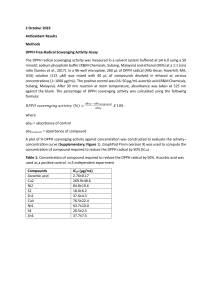
![benzo[d] isoxazole: In vitro Antimicrobial and Antioxidant activity](http://s3.studylib.net/store/data/007006684_1-684f7b1d721ca4abfe74cc96e54598b2-300x300.png)
